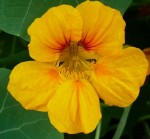 Also called Indian cress, this trailing annual is in the family Tropaeolaceae and is native to the Andes from Bolivia to Colombia. Plants grow 2-12″ tall or more with support and spread up to 10 feet. They hug the ground but will climb if given some support. The leaves are almost round, peltate, and held on long petioles. The five petaled flowers are spurred. 1 to 2.5 inches across, and yellow, orange, or red. They bloom from mid-summer to fall and give way to three seeded fruits 3/4 inch across. Nasturtiums do best in cool climates where night time temperatures in summer are below 70 F. They like full sun and moist, well-drained soil. Propagation is by seed and plants may self-seed. The common name, nasturtium ,is the genus name for water cress (Nasturtium officinale, a plant unrelated to this Tropaeolum majus) and comes from the Latin nos meaning nose and tortum meaning twist referring to the flower’s scent that makes people’s nose twist when they eat it. The other common name, Indian cress, comes from the false belief that South America where the plant was first found was the Indies, and use of the plant in salad was like cress. The genus name, Tropaeolum, comes from the Greek word tropaion/ Latin word tropaeum, meaning trophy, and refers to the custom of the Romans in the battlefield when they hung the shields (the round leaves) and blood stained helmets (flowers) of the vanquished on pillars. Presumably, the look of the pillars with the trophies was similar to the flowering vine growing on a support. The specific epithet, majus, is the Latin word meaning larger.
Also called Indian cress, this trailing annual is in the family Tropaeolaceae and is native to the Andes from Bolivia to Colombia. Plants grow 2-12″ tall or more with support and spread up to 10 feet. They hug the ground but will climb if given some support. The leaves are almost round, peltate, and held on long petioles. The five petaled flowers are spurred. 1 to 2.5 inches across, and yellow, orange, or red. They bloom from mid-summer to fall and give way to three seeded fruits 3/4 inch across. Nasturtiums do best in cool climates where night time temperatures in summer are below 70 F. They like full sun and moist, well-drained soil. Propagation is by seed and plants may self-seed. The common name, nasturtium ,is the genus name for water cress (Nasturtium officinale, a plant unrelated to this Tropaeolum majus) and comes from the Latin nos meaning nose and tortum meaning twist referring to the flower’s scent that makes people’s nose twist when they eat it. The other common name, Indian cress, comes from the false belief that South America where the plant was first found was the Indies, and use of the plant in salad was like cress. The genus name, Tropaeolum, comes from the Greek word tropaion/ Latin word tropaeum, meaning trophy, and refers to the custom of the Romans in the battlefield when they hung the shields (the round leaves) and blood stained helmets (flowers) of the vanquished on pillars. Presumably, the look of the pillars with the trophies was similar to the flowering vine growing on a support. The specific epithet, majus, is the Latin word meaning larger.
Tropaeolum majus was introduced into Spain from Peru by 1569 and into England by 1686. The plant lists in 1759 and 1761 of the Moravian farm at the Bethabara settlement in North Carlina includes it, and John Randolph living in Williambsburg, mentions in is Treatise on Gardening (1793). Randolph gives planting direcrtions and notes that ” the flower is superior to a reddish in flavour, and is eat in sallads or without.” Records from the Moravian settlement suggest that the pickled fruits of the plant were considered a good substitute for capers and in 1774, Thomas Jefferson reported that he planted his nasturtiums in 35 little hills at Monticello, perhaps an indication of how delicious the plant was. considered. By the 19th century nasturtiums were popular in cottage gardens of both England and America and today people not only grow them for the color that he flowers add to gardens but also for the edible treats they provide. Valued for their peppery flavor, the flowers and leaves are eaten in salads and used to flavor oils, vinegars, dips, mayonnaise, and black beans cooked with corn .